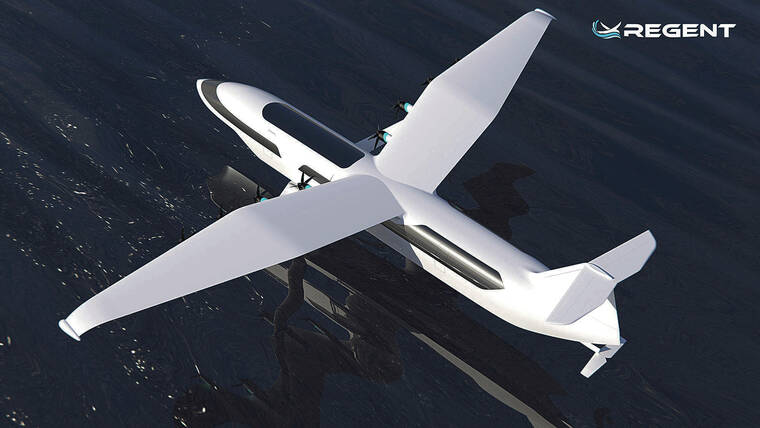Hawaiian Airlines investing in electric seaglider

COURTESY REGENT
An artist’s rendering shows the 100-passenger “Monarch seaglider” interisland electric plane.
Hawaiian Airlines has invested in an all-electric, no-emission, propeller-driven plane that would take off from sea, fly just the length of a wing over the surface of the ocean and land at neighbor island docks without touching land.
Hawaiian and Boston- based REGENT (Regional Electric Ground Effect Nautical Transport) hope to have the first 100-passenger “Monarch seaglider” available in 2028.
Passengers would likely board the Monarch from docks and avoid traditional airports.
Flights would undergo three stages, starting with floating on the Monarch’s hull, picking up speed on its hydrofoil and then taking flight at 180 mph flying just one wingspan’s length above the ocean, REGENT said. The maximum distance is expected to be 180 miles with up to 500 miles from the next generation of batteries.
The 100-passenger Monarch is expected to follow REGENT’s 12-passenger Viceroy seaglider Opens in a new tab, which is scheduled to be available in 2025.
Hawaiian has not disclosed the amount of its equity investment in REGENT, but Hawaiian is also providing its expertise flying interisland to help design the plane.
Don't miss out on what's happening!
Stay in touch with breaking news, as it happens, conveniently in your email inbox. It's FREE!
The larger Monarch is in the “very, very early phases of design,” said Avi Mannis, Hawaiian’s chief marketing and communications officer. “We don’t frankly know what they’re going to look like.”
Other key aspects also need to be figured out, Mannis said, including how the Monarch will perform in Hawaiian’s “high frequency, short flight” operations; how to get passengers on and off; and “where it should operate and what infrastructure is required.”
“That’s our role,” he said.
With a speed of 180 mph, Mannis said seaglider flights could last longer than Hawaiian’s current interisland, jet plane flights. But the idea is to speed up passengers’ total travel time by avoiding isle airports.
With nontraditional takeoffs and landings, coupled with low-altitude flights, Mannis said, “I hope it will be fun.”
Hawaiian Airlines is now in its 93rd year of operations, and the seaglider concept harks back to Hawaiian’s early days flying Sikorski seaplanes interisland, Mannis said.
The seaglider would not initially replace Hawaiian’s traditional interisland fleet of 19 Boeing 717s and 18 Airbus A321 Neos, which fly an average of 130 flights per day.
But Hawaiian’s interest in the seaglider represents its overall effort to become more fuel-efficient and transition to emission-free operations, Mannis said.
“It is a next concept that we’re exploring,” he said. “Our view at this moment is this is probably a complement … rather than a replacement.”



